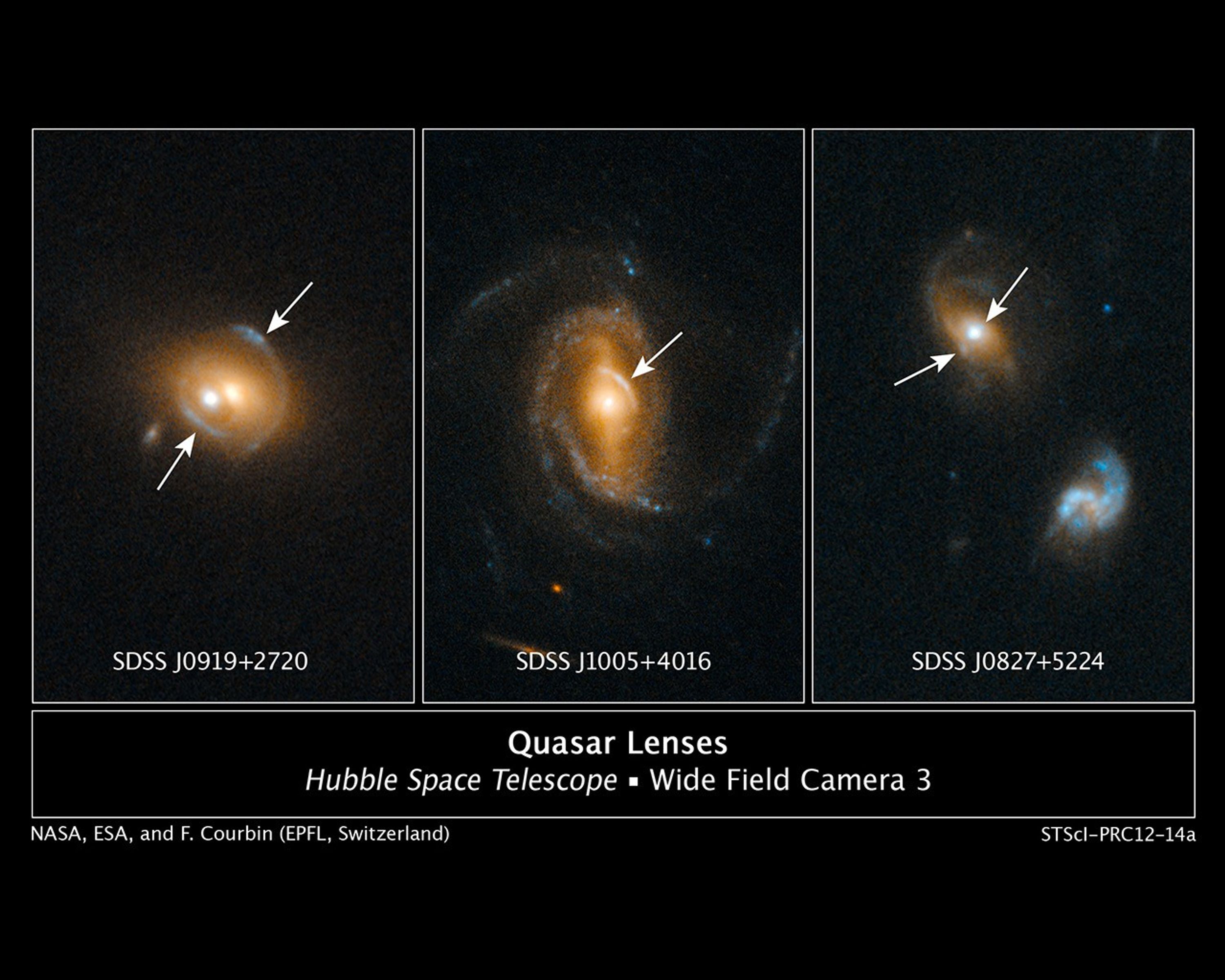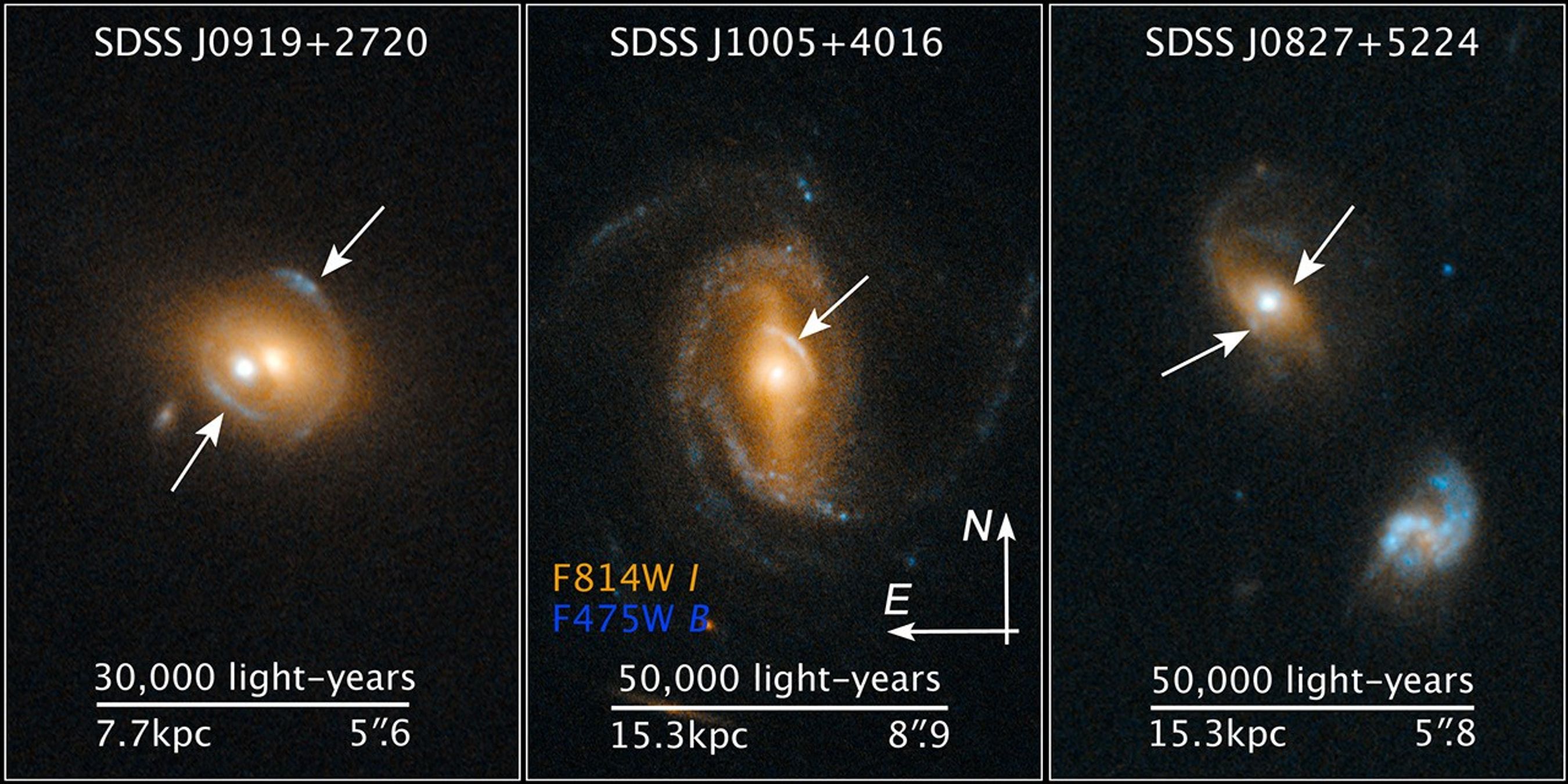1 min read
Quasar Lenses

Astronomers using NASA's Hubble Space Telescope have found several examples of galaxies containing quasars, which act as gravitational lenses, amplifying and distorting images of galaxies aligned behind them.
Quasars are among the brightest objects in the universe, far outshining the total starlight of their host galaxies. Quasars are powered by supermassive black holes.
To find these rare cases of galaxy-quasar combinations acting as lenses, a team of astronomers led by Frederic Courbin at the Ecole Polytechnique Federale de Lausanne (EPFL, Switzerland) selected 23,000 quasar spectra in the Sloan Digital Sky Survey (SDSS). They looked for the spectral imprint of galaxies at much greater distances that happened to align with foreground galaxies. Once candidates were identified, Hubble's sharp view was used to look for gravitational arcs and rings (which are indicated by the arrows in these three Hubble photos) that would be produced by gravitational lensing.
Quasar host galaxies are hard or even impossible to see because the central quasar far outshines the galaxy. Therefore, it is difficult to estimate the mass of a host galaxy based on the collective brightness of its stars. However, gravitational lensing candidates are invaluable for estimating the mass of a quasar's host galaxy because the amount of distortion in the lens can be used to estimate a galaxy's mass.
About the Data
- Data DescriptionData DescriptionProposal: A description of the observations, their scientific justification, and the links to the data available in the science archive.
Science Team: The astronomers who planned the observations and analyzed the data. "PI" refers to the Principal Investigator.The image was created from Hubble data from proposal 12233: F. Courbin, G. Meylan, M. Tewes, and P. Jablonka (EPFL, Switzerland), S.G. Djorgovski and A. Mahabal (Caltech), P. Magain (Universite de Liege, Belgium), and D. Sluse (Bonn University, Germany). The science team includes: F. Courbin, C. Faure, F. Rerat, M. Tewes, and G. Meylan (EPFL, Switzerland), S.G. Djorgovski and A. Mahabal (Caltech), D. Stern (JPL), T. Boroson (NOAO), D. Sluse (Bonn University, Germany), and R. Dheeraj (University of Maryland). - InstrumentInstrumentThe science instrument used to produce the data.HST>WFC3/UVIS
- Exposure DatesExposure DatesThe date(s) that the telescope made its observations and the total exposure time.February 26 - March 12, 2011
- FiltersFiltersThe camera filters that were used in the science observations.F475W (B), F814W (I)
- Object NameObject NameA name or catalog number that astronomers use to identify an astronomical object.SDSS J0919+2720,SDSS J1005+4016,SDSS J0827+5224
- Object DescriptionObject DescriptionThe type of astronomical object.QSO gravitational lenses on background emission-line galaxies
- Release DateMarch 15, 2012
- Science ReleaseAstronomers Using NASA’s Hubble Discover Quasars Acting as Gravitational Lenses
- Credit

This image is a composite of separate exposures acquired by the WFC3 UVIS instrument. Several filters were used to sample various wavelength and energy ranges. The color results from assigning different hues (colors) to each monochromatic (grayscale) image associated with an individual filter. In this case, the assigned colors are: Blue: F475W (B) Orange: F814W (I)

Share
Details
Claire Andreoli
NASA’s Goddard Space Flight Center
Greenbelt, Maryland
claire.andreoli@nasa.gov
































